全文HTML
--> --> -->材料Te具有特殊的准一维能带嵌套结构和相对复杂的晶体结构, 使得其在电输运和热输运性质上具有可协同调控的优点, 因此受到热电领域越来越多的关注[9,10]. 由于熔点限制, Te工作的最佳服役温度范围小于600 K, 优化改善后的Te基热电材料ZT值最高可达1.0左右[6,11]. Te与电极材料连接形成稳定的界面是该类热电器件的技术关键. 高质量的连接界面要求热电材料与电极材料间有适当的扩散反应, 良好的界面性能, 并且还要有一定的机械稳定性和热稳定[12-14]. 传统的电极材料包括Cu, Fe, Ag, Ni等[15]都普遍用于热电器件的制备, 但是由于较强的金属活性, Te与许多金属连接时都普遍存在严重的交互扩散甚至化学反应. PbTe与Cu的连接实验表明, Cu和Te在连接界面处向彼此的基体内快速扩散, 同时在扩散区形成大量的Cu2Te相, 导致铜电极大量消耗[6,16]. Ag具备了电极材料优良的性质, 但昂贵的价格限制了其作为电极的应用范围. Singh等[17]在PbTe基热电材料连接时选用Fe作为电极, 虽然在界面处形成了一定厚度的反应层, 但反应层在其间稳定存在, 并且连接界面处组织均匀, 无缺陷, 展现了理想的界面质量. 所以综合性能、经济等多方面因素, 在Te基热电材料连接中, 本研究尝试选择Fe作为对应电极.
在研究初期采用放电等离子烧结技术(SPS)一步合成法制备了Te/Fe热电接头, 但发现Te与Fe间同样存在严重的元素交互扩散问题, 并在扩散区域形成多种新相, 界面局部区域产生残余应力组织开裂. 为了解决元素严重扩散和残余应力等界面问题, 本研究并没有采用常规方法直接引用活性较低的金属作为阻隔层[18], 而是设计了具有梯度连接结构特性的热电接头Te/β(FeTe)/Fe, 并通过SPS一步合成法制备. 本设计提出的多元梯度势场概念, 是通过引入成分梯度、载流子浓度梯度、热膨胀系数梯度等多元势场, 对界面粒子传输过程进行协同调控, 同时实现抑制界面扩散、减小界面热应力等目的. 实验结果显示这种梯度连接结构实现了中低温材料的高质量连接.
 图 1 (a) 热电接头Te/Fe界面接触电阻测试示意图; (b) 梯度连接结构Te/β(FeTe)/Fe抗剪强度测试示意图
图 1 (a) 热电接头Te/Fe界面接触电阻测试示意图; (b) 梯度连接结构Te/β(FeTe)/Fe抗剪强度测试示意图Figure1. Schematic diagram of (a) thermoelectric joint Te/Fe interface contact resistance test and (b) shear strength test of Te/β(FeTe)/Fe gradient structure.
研究第二个阶段引入FexTey作为热电材料和电极材料的阻隔层, 制备了梯度连接结构Te/FexTey/Fe. 分别以1∶1和2∶1的化学计量比称量碲和铁的混合粉末, 然后在高速球磨机(QM-3B)中球磨1 h, 球粉质量比为10∶1, 分别制得β(FeTe)相和ε(FeTe2)相. 通过Seebeck测试系统(Namicro-3)对制得的β(FeTe)和ε(FeTe2)的电性能进行测试, 测试温度区间为300—600 K. 按先后顺序将研磨好的Te粉、β(FeTe) (或ε(FeTe2))以及称量好的Fe粉依次置于直径为17 mm的石墨模具中以形成Te/FexTey/Fe结构, 在模具两端加入两个石墨柱塞, 所有操作均在惰性气体气氛下进行. 实验参数设置为688 K, 50 MPa, 其余实验条件以及界面分析测试手段同实验前期相同. 此外, 为了研究梯度连接结构的机械性能, 采用微机控制的电子万能试验机(DNS200)测试了试样界面的抗剪强度, 测试样本规格是7 mm × 7 mm × h (4—5 mm), h代表试样厚度. 该实验过程的示意图如图1(b)所示. 最后, 为了探究连接结构在高温下的热稳定性, 将样品密封在真空石英管中, 在523—573 K下退火不同时间(3, 7, 10, 15 d)后, 对连接结构界面组织结构变化进行观察分析, 对退火前后样品的界面性能进行测试对比.
3.1.Te/Fe热电接头的性能
对实验前期制备的Te/Fe连接界面接触电阻进行测试, 但是发现测试结果有较大的跳动幅度, 进一步对热电接头连接界面处的组织结构、元素分布以及相组成进行观察分析, 结果如图2所示. 从图2(b)和图2(c)中可以发现扩散连接过程中Te和Fe元素交互扩散严重, 并且图2(a)显示在Fe周围分布有扩散反应后产生的浅灰色新相, 如点a1所示, 对其进行EDS点扫, 得到的其成分图谱如图2(d)所示, 元素成分比例与FeTe2相近. 界面处局部有宏观裂纹存在, 经查阅资料[19]得知二者的热膨胀系数(CTE)相差较大(CTETe = 20 × 10–6/K, CTEFe = 11.8 × 10–6/K), 所以可以判断这是烧结冷却过程中产生的局部残余应力导致的应力性开裂[20]. 以上结果表明, 无论是界面微观组织结构的质量, 还是元素分布的合理性, Te/Fe热电接头均体现较差的界面质量.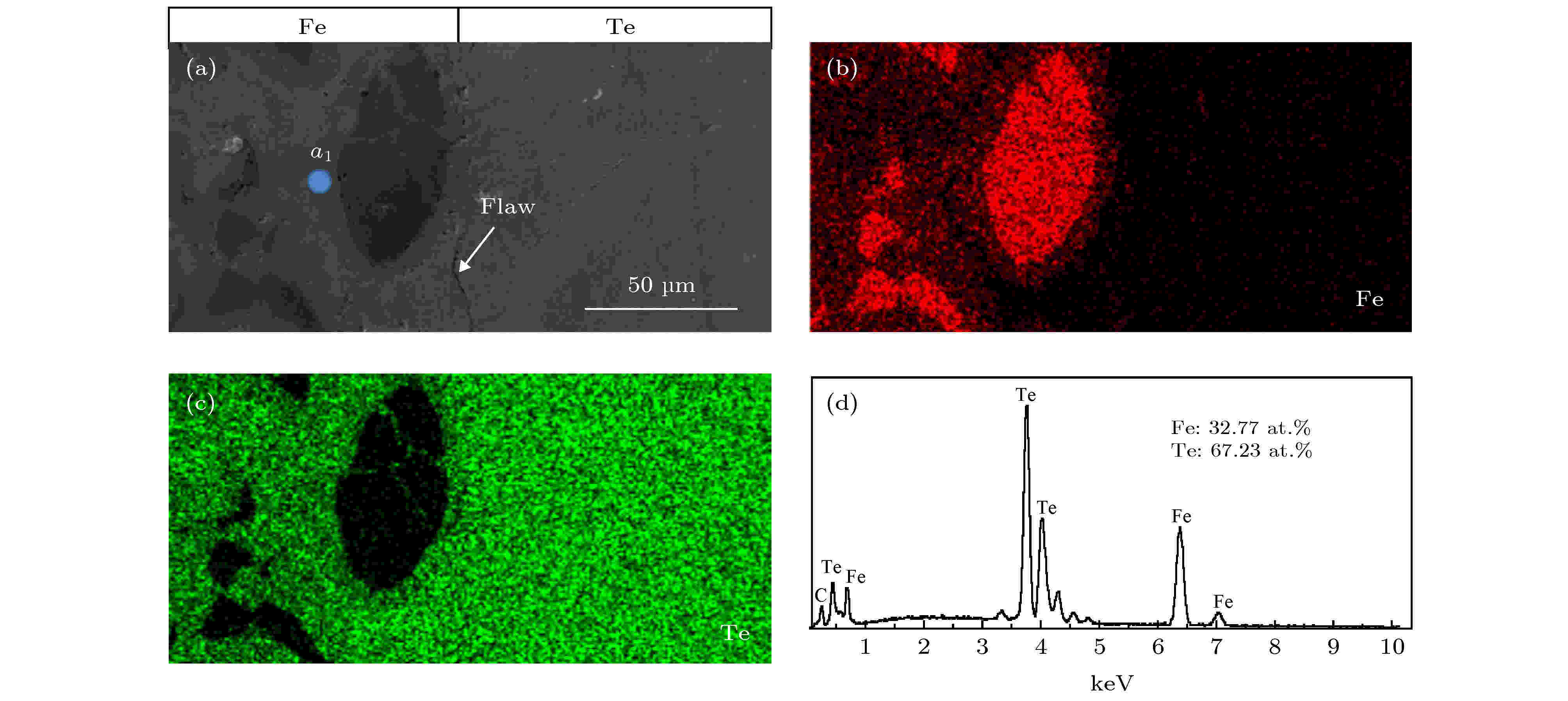 图 2 (a)热电接头Te/Fe界面背散射电子图片; (b) Fe和(c) Te的元素分布; (d) 热电接头Te/Fe界面新相元素成分谱图
图 2 (a)热电接头Te/Fe界面背散射电子图片; (b) Fe和(c) Te的元素分布; (d) 热电接头Te/Fe界面新相元素成分谱图Figure2. (a) Back scattering image of the Te/Fe interface; elemental mappings of (b) Fe and (c) Te, respectively; (d) elemental composition spectrum of new phase at the Te/Fe interface.
2
3.2.β(FeTe)相和ε(FeTe2)相的电性能测试
为了解决界面元素的过度扩散以及界面质量差等问题, 本研究第二阶段基于多元梯度势场对界面粒子传输过程的协同调控作用, 引入Te和Fe的金属化合物作为Te-Fe间的阻隔层, 形成Te/FexTey/Fe梯度连接结构. 希望通过多元梯度势场效应的作用, 实现抑制界面元素过度扩散、降低界面接触电阻以及界面残余应力的目的. 观察Te和Fe的二元相图(如图3)发现, 二者之间存在的物相主要有β(FeTe), ε(FeTe2)两种. 作为热电材料和电极材料间的阻隔层, 其电性能对热电接头的性能影响较大, 将直接影响热电接头的电输运性能. 对二者Seebeck系数和电阻率进行测试, 结果如图4所示. 从图4(a)中显示的结果可以发现, β(FeTe)和ε(FeTe2)的电阻率都随温度的升高而降低, 表明两种化合物都属于半导体性质. 此外, 图4(b)中显示的Seebeck测试结果表明化合物β(FeTe)和ε(FeTe2)均属于P型半导体, 与Te基半导体热电材料属同一类型, 因此在与Te连接时界面不会形成过高的肖特基势垒.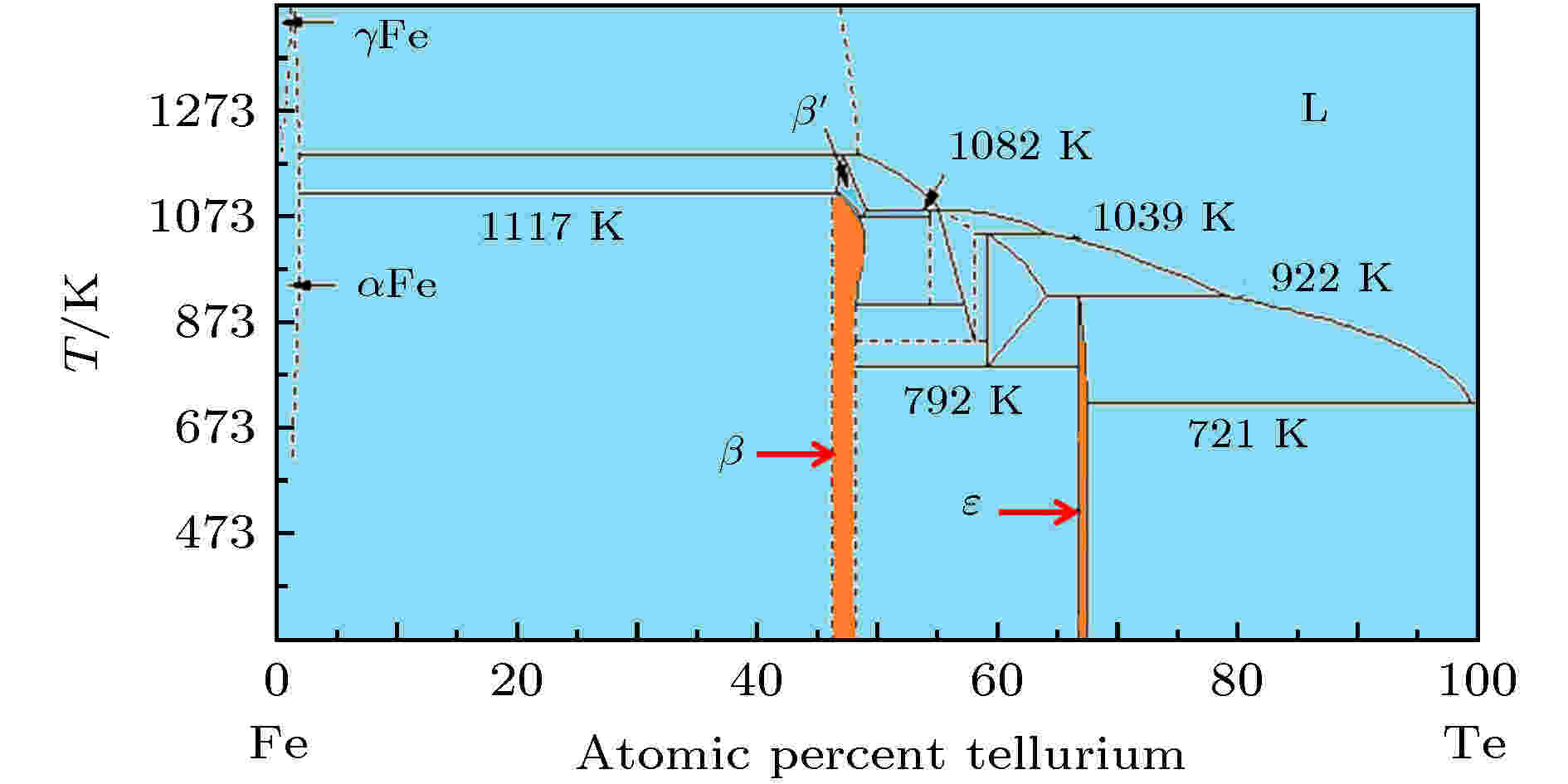 图 3 Fe-Te二元合金相图(来源: 美国材料信息学会)
图 3 Fe-Te二元合金相图(来源: 美国材料信息学会)Figure3. Binary phase diagram of Fe-Te (Quoted from the materials information society, ASM Interantional).
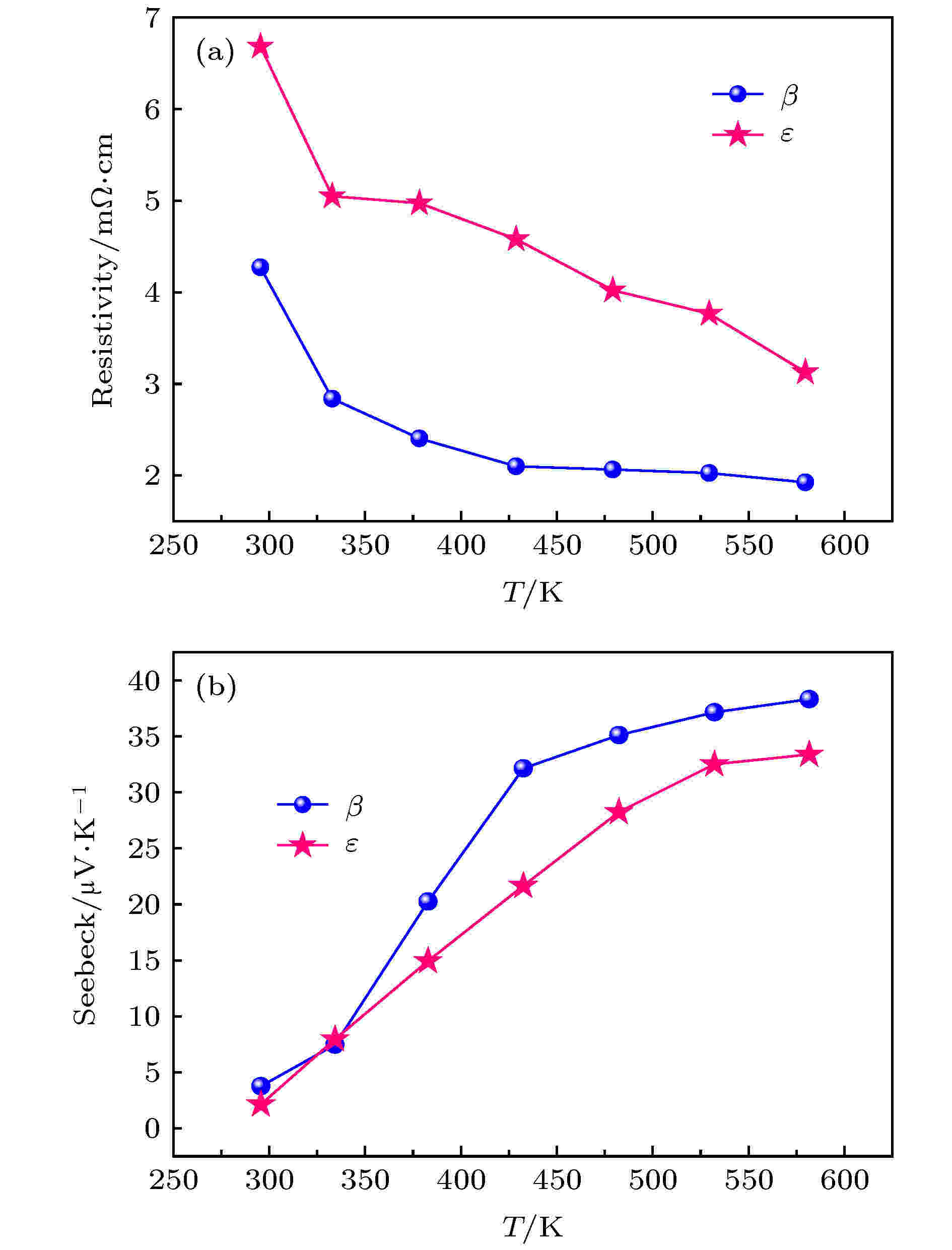 图 4 β(FeTe), ε(FeTe2)的电性能测试结果 (a)电阻率; (b) Seebeck系数
图 4 β(FeTe), ε(FeTe2)的电性能测试结果 (a)电阻率; (b) Seebeck系数Figure4. The electrical properties of β(FeTe) and ε(FeTe2): (a) Resistivity; (b) Seebeck coefficient.
2
3.3.梯度连接结构Te/β(FeTe)/Fe和Te/ε (FeTe2)/Fe的性能
在Te/Fe间引入β(FeTe)和ε(FeTe2)后制备了梯度连接结构Te/FexTey/Fe. 首先, 在扫描电子显微镜下对两种接头形成的界面行为进行分析, 结果如图5所示. 由图5(a)可见, 在Te/β(FeTe)/Fe热电接头中, 两个界面的微观组织结构致密均匀, 连接良好, 在β(FeTe)与Te的界面处形成了一个宽度约为40 μm均匀致密的反应层, EDS点扫结果(如表1)显示反应层的主要成分是FeTe2, 即ε相. 所以可以判断在烧结过程的高温下Te-β(FeTe)的界面处发生了反应: FeTe+Te → FeTe2. 致密的ε(FeTe2)层为Te/β(FeTe)/Fe连接结构提供了良好的界面, 这有利于热电模块工作时的电输运. 而β(FeTe)与Fe的界面处则形成了均匀的固溶体. 所以在Te-Fe间引入β(FeTe)作为阻隔层, 最终形成的连接结构是Te/ε(FeTe2)/ β(FeTe)/Fe, EDS扫描结果(图5(d))表明, β(FeTe)相的引入有效地解决了电极材料Fe和热电材料Te间严重的元素交互扩散问题.| Point number | Fe /at.% | Te /at.% |
| b1 | 0 | 100.00 |
| b2 | 29.92 | 70.08 |
| b3 | 50.30 | 49.70 |
| b4 | 100.00 | 0 |
| b5 | 31.05 | 68.95 |
| b6 | 17.10 | 82.90 |
表1梯度连接结构Te/β(FeTe)/Fe和 Te/ε(FeTe2)/Fe区域成分扫描结果
Table1.EDS point scanning results of Te/β(FeTe)/Fe and Fe/ε(FeTe2)/Fe.
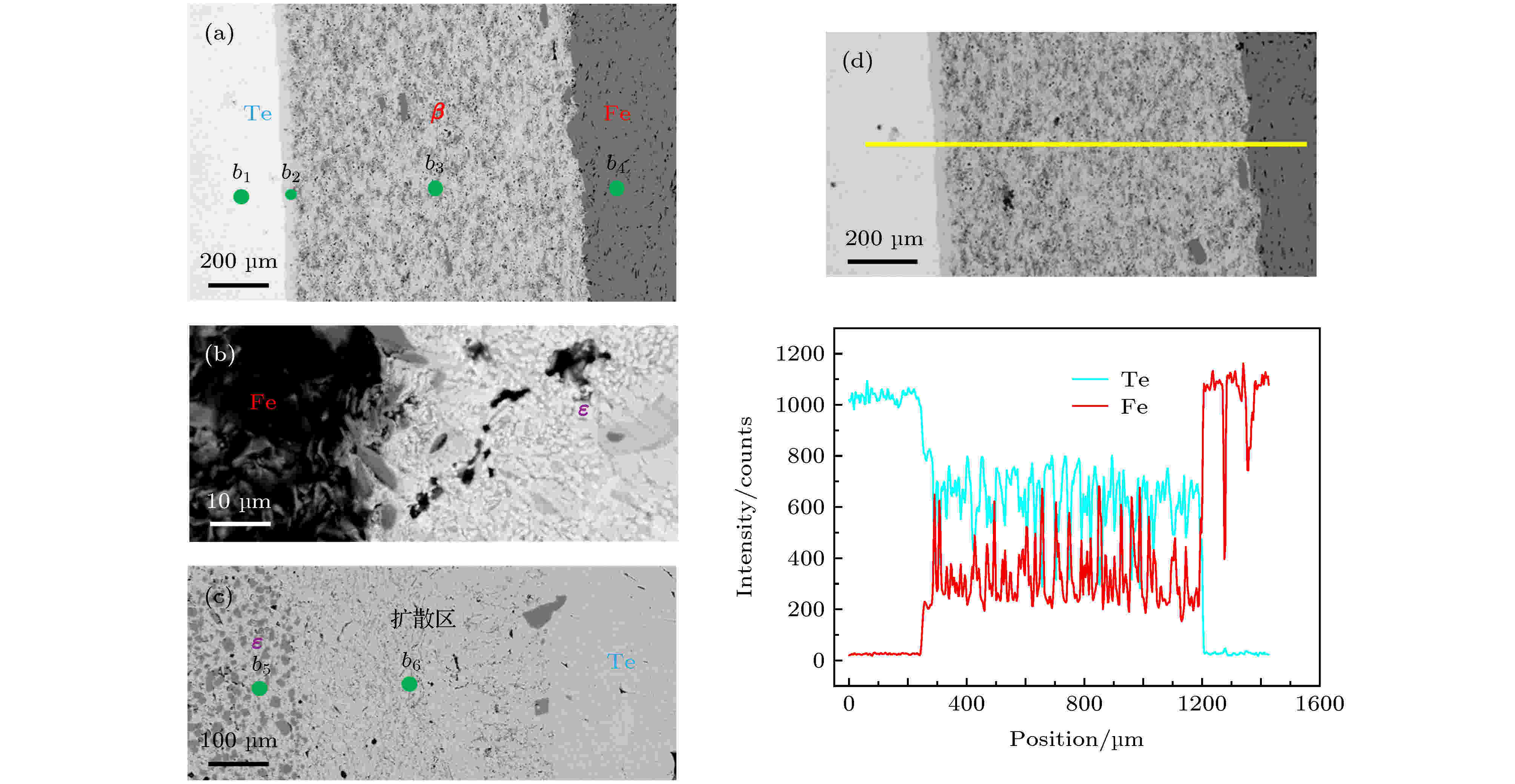 图 5 (a)梯度连接结构Te/FeTe/Fe界面微观组织结构; (b), (c) 梯度连接结构Te/ε(FeTe2)/Fe界面微观组织结构; (d)梯度连接结构Te/β(FeTe)/Fe的EDS线扫
图 5 (a)梯度连接结构Te/FeTe/Fe界面微观组织结构; (b), (c) 梯度连接结构Te/ε(FeTe2)/Fe界面微观组织结构; (d)梯度连接结构Te/β(FeTe)/Fe的EDS线扫Figure5. Microstructure of gradient bonding structure: (a) Te/FeTe/Fe interface; (b), (c) Te/ε(FeTe2)/Fe interface; (d) EDS line scanning of Te/β(FeTe)/Fe.
然而对于热电接头Te/ε(FeTe2)/Fe, 结果却并不理想, 扫描电子显微镜下观察到的界面组织结构如图5(b)和图5(c)所示. 首先在图5(b)中可以看到ε(FeTe2)与Fe间的界面处组织结构尺寸不均匀, 削弱了界面机械性能, 在图5(c)中可以看到ε(FeTe2)与Te的界面处存在较宽的扩散区, 根据Fe-Te的二元相图可知, 二者形成的物相中Te所占原子比最大的即为ε(FeTe2), 所以扩散区主要是Te和Fe两种元素的混合区, 并没有发生化学反应产生确定的物相, 混合区的形成会削弱热电材料和电极材料的界面电输运性能.
为了研究梯度连接结构Te/β(FeTe)/Fe的界面性能, 首先对其界面接触电阻进行了测试, 测试原理和结果如图6所示. 外侧两探针测试的是整个连接结构的电阻Rtot = RFe + RFe/β + Rβ + RTe/β + RTe, 而内侧两探针主要测试界面阻抗变化RFe/β和RTe/β, 其中Te和β(FeTe)之间存在反应层ε(FeTe2), 所以RTe/β≈Rε. β(FeTe)与Fe和Te间的接触电阻分别为4.10和7.54 μΩ·cm2. 对梯度连接结构的两个界面的机械性能进行测试, 实验结果显示β(FeTe)-Te和β(FeTe)-Fe的连接界面处的剪切强度分别为15.63和16.11 MPa. 梯度结构的两界面在保持较低接触电阻的同时, 展现出理想的机械性能, 满足了本实验设计的要求.
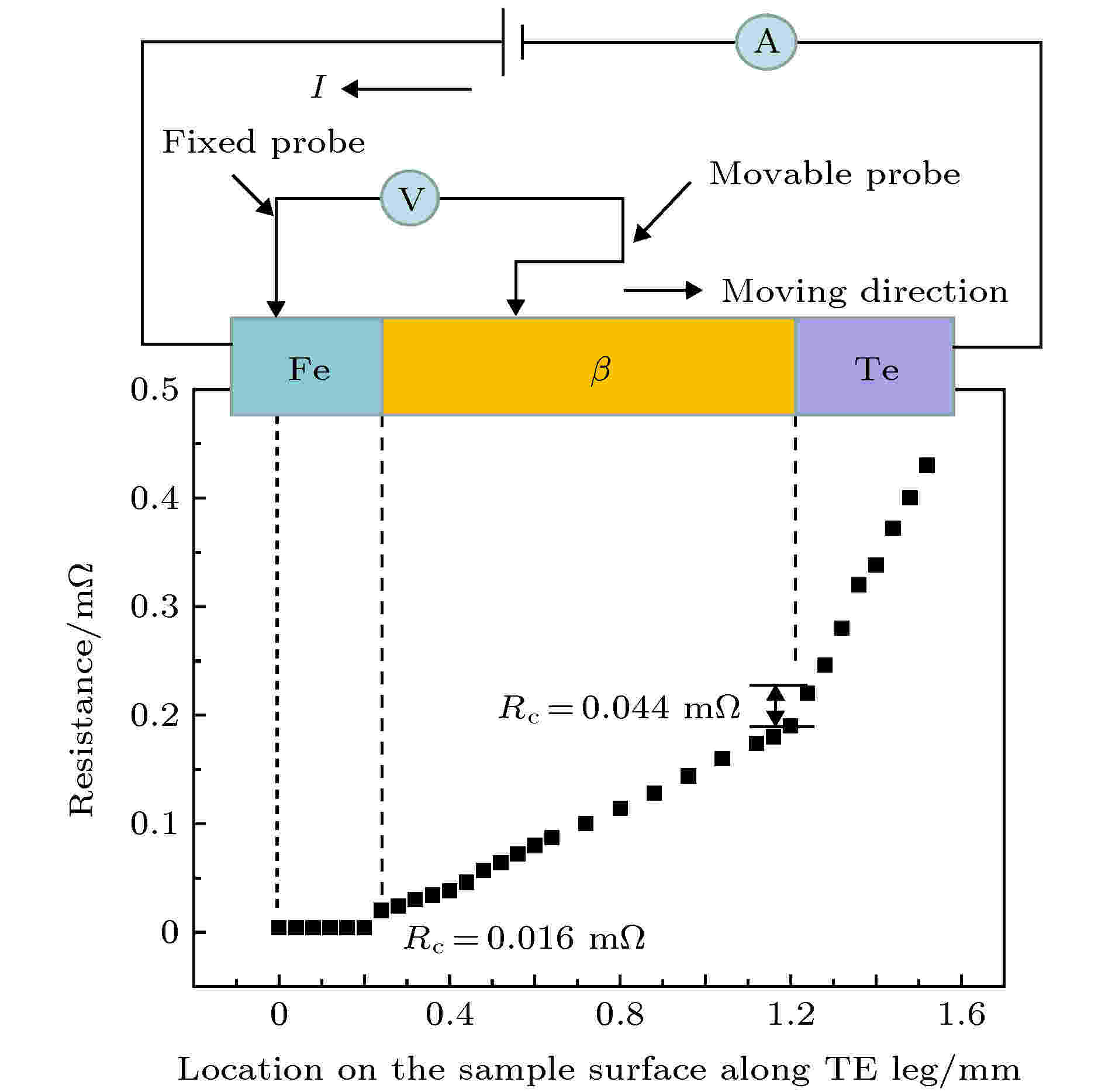 图 6 梯度连接结构Te/β(FeTe)/Fe界面接触电阻测试示意图
图 6 梯度连接结构Te/β(FeTe)/Fe界面接触电阻测试示意图Figure6. Schematic diagram of Te/β(FeTe)/Fe interface contact resistance test.
由于梯度结构Te/β(FeTe)/Fe的β(FeTe)-Te界面处存在ε(FeTe2)成分组成的反应层, 为了探究这个反应层成分对界面机械性能的影响, 对试样剪切实验后的β(FeTe)-Te断面形貌和成分分布分别进行了SEM和EDS扫描, 实验结果如图7所示. 从图7(a)可以看到断口表面的整体特征为不平整、无光泽, 而且组织形貌多样, 可以判断界面断裂过程是发生在多相间的韧性断裂. 对图7(a)中断面局部区域放大观察并进行EDS分析, 结果如图7(b)所示. 可以看出, 断面处组织结构复杂, 在块状结构上分布有枝条状组织, 结合EDS分析结果(如表2所列)可以知道, 点1, 2, 3的元素成分分别对应ε(FeTe2), β(FeTe)和Te, ε(FeTe2)相和本征Te占整个断口区域的比例较大, 而结构特征为枝条状的β(FeTe)相以很小的比例存在. 因此可以判断Te-(ε(FeTe2))-β(FeTe)界面剪切实验的断裂部位主要发生在反应层ε(FeTe2)偏Te一侧, 而反应层ε(FeTe2)与β(FeTe)间则由于枝条状的β(FeTe)相晶粒的强化作用, 提高了其界面的机械强度.
| Point number | Fe/at.% | Te/at.% |
| 1 | 24.66 | 75.34 |
| 2 | 60.17 | 39.83 |
| 3 | 2.54 | 97.46 |
表2β(FeTe)-Te界面断口特征点EDS成分扫描结果
Table2.EDS scanning results of characteristic points of β(FeTe)-Te fracture interface.
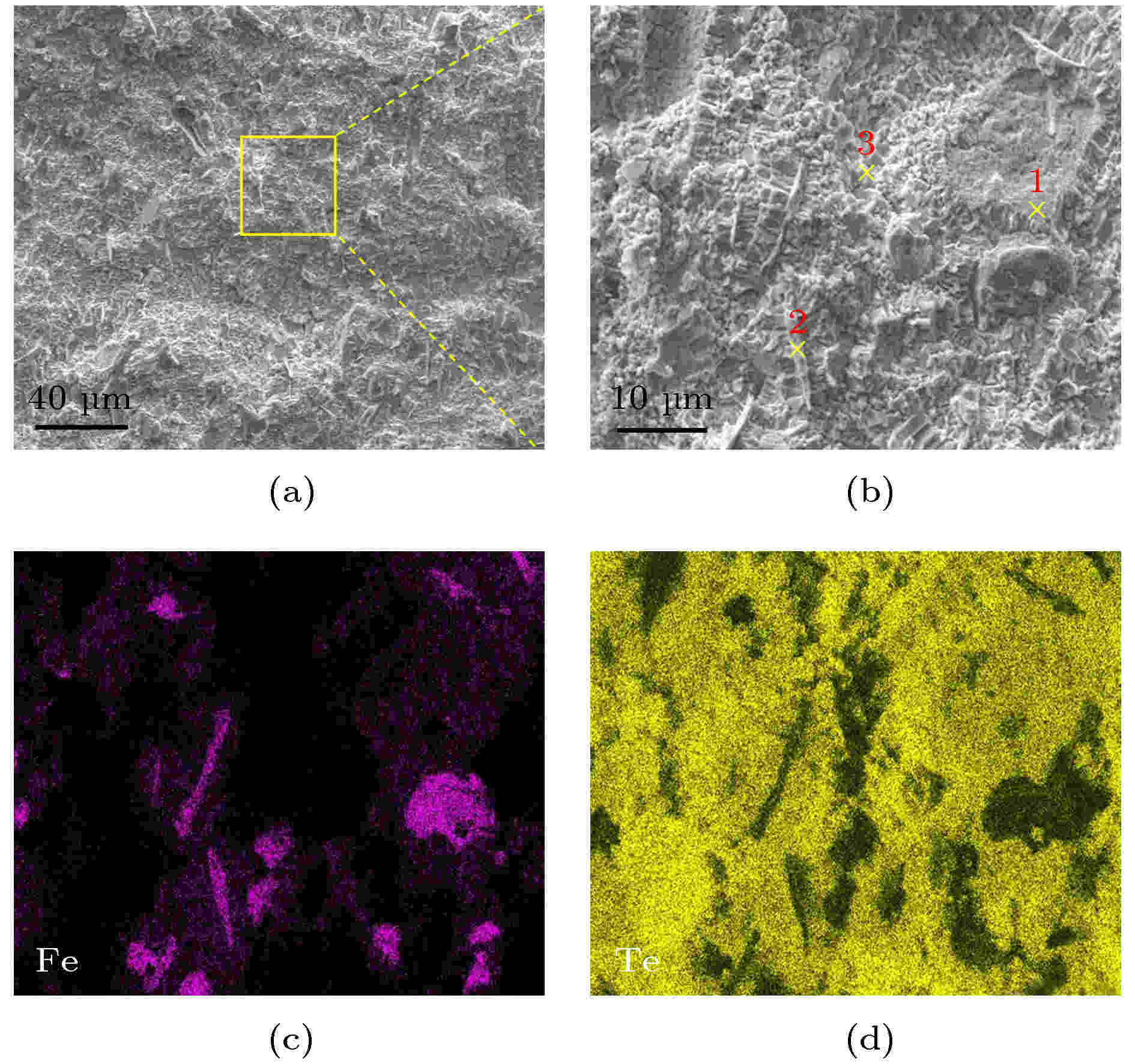 图 7 梯度连接结构Te/β(FeTe)/Fe的β(FeTe)-Te界面断口微观组织形貌和元素成分分布
图 7 梯度连接结构Te/β(FeTe)/Fe的β(FeTe)-Te界面断口微观组织形貌和元素成分分布Figure7. Microstructure morphology and elemental distribution of the β(FeTe)-Te fracture interface of Te/β(FeTe)/Fe.
2
3.4.长时间退火对热电接头Te/β(FeTe)/Fe组织结构及性能的影响
为了研究热电接头组织结构及性能在高温下的热稳定性, 将热电接头置于真空环境553 K进行不同时间的退火处理. 在扫描电子显微镜下对退火后样品的界面组织结构和相组成的变化进行了观察分析, β(FeTe)-Te界面和β(FeTe)-Fe界面的组织结构如图8所示. 从图8(b1)中可以发现在553 K下退火7 d后, β(FeTe)-Te间反应层ε(FeTe2)的厚度明显变薄, 而再次延长退火时间后, 反应层ε(FeTe2)厚度又保持稳定, 如图8(c1)和图8(d1)所示. 对照相图分析发现, 界面处的ε(FeTe2)与两侧材料(Te和β(FeTe))不会发生化学反应, 所以排除化学反应因素的影响. 反应层ε(FeTe2)的生成是Te与β(FeTe)在高温下扩散反应的结果, 在生成ε(FeTe2)的同时, 也对Te与β(FeTe)的进一步扩散反应产生阻碍. 界面处元素的扩散是一个热激活过程, 与温度有关的扩散系数可以表示为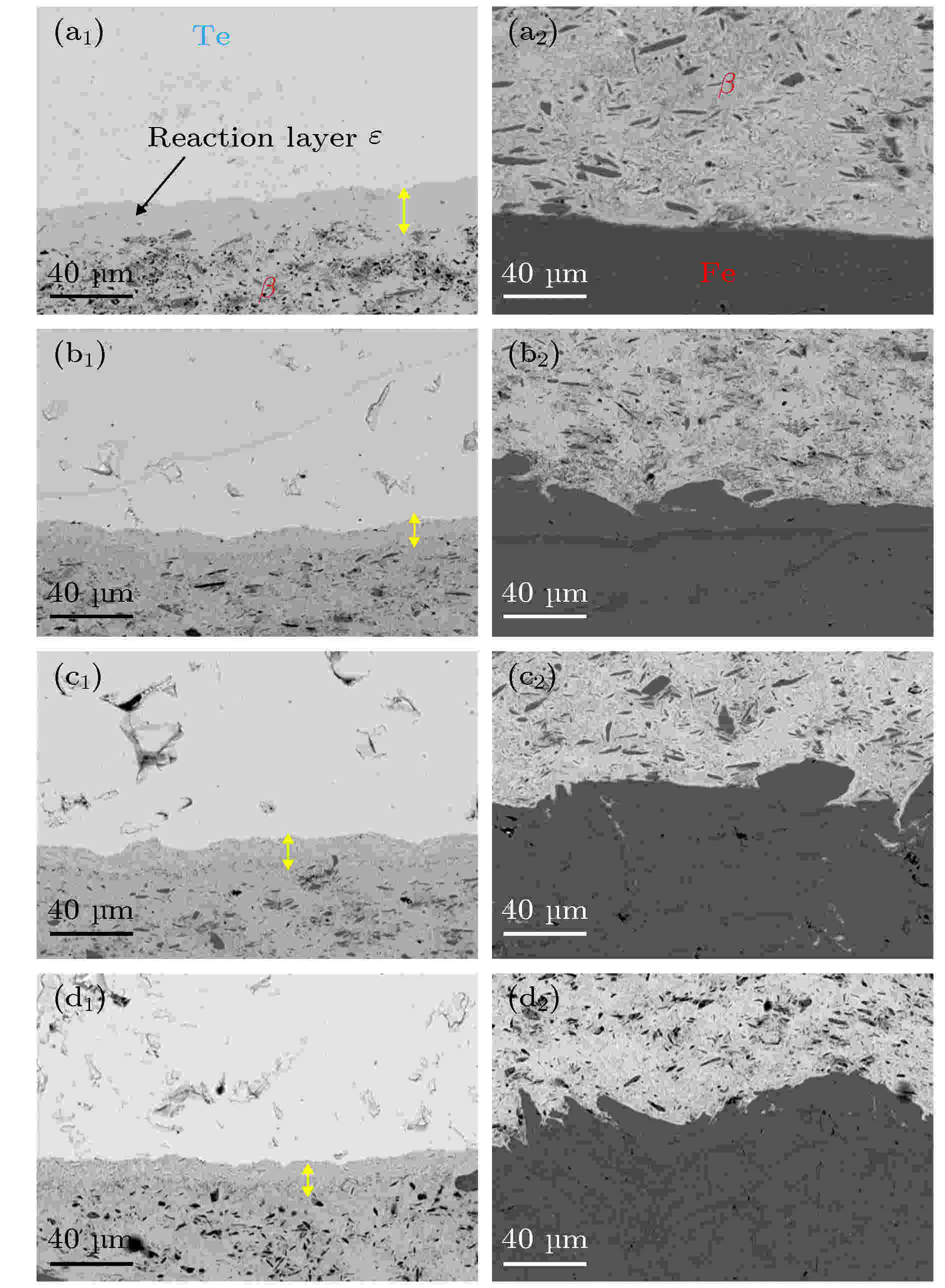 图 8 梯度连接结构Te/β(FeTe)/Fe在553 K下退火不同时间后两界面组织结构图片 (a1), (a2) 0 d; (b1), (b2) 7 d; (c1), (c2) 10 d; (d1), (d2) 15 d
图 8 梯度连接结构Te/β(FeTe)/Fe在553 K下退火不同时间后两界面组织结构图片 (a1), (a2) 0 d; (b1), (b2) 7 d; (c1), (c2) 10 d; (d1), (d2) 15 dFigure8. Interface structure pictures of Te/β(FeTe)/Fe after annealing at 553 K for different time: (a1), (a2) 0 d; (b1), (b2) 7 d; (c1), (c2) 10 d; (d1), (d2) 15 d.
为了进一步探究梯度结构Te/β(FeTe)/Fe在更高温度下的服役稳定性, 将热电接头置于真空环境573 K下进行不同时间的退火处理. 但是在第10 天的时候, 连接结构的β(FeTe)-Te界面处就出现完全断裂, 如图9所示, 构件失效.
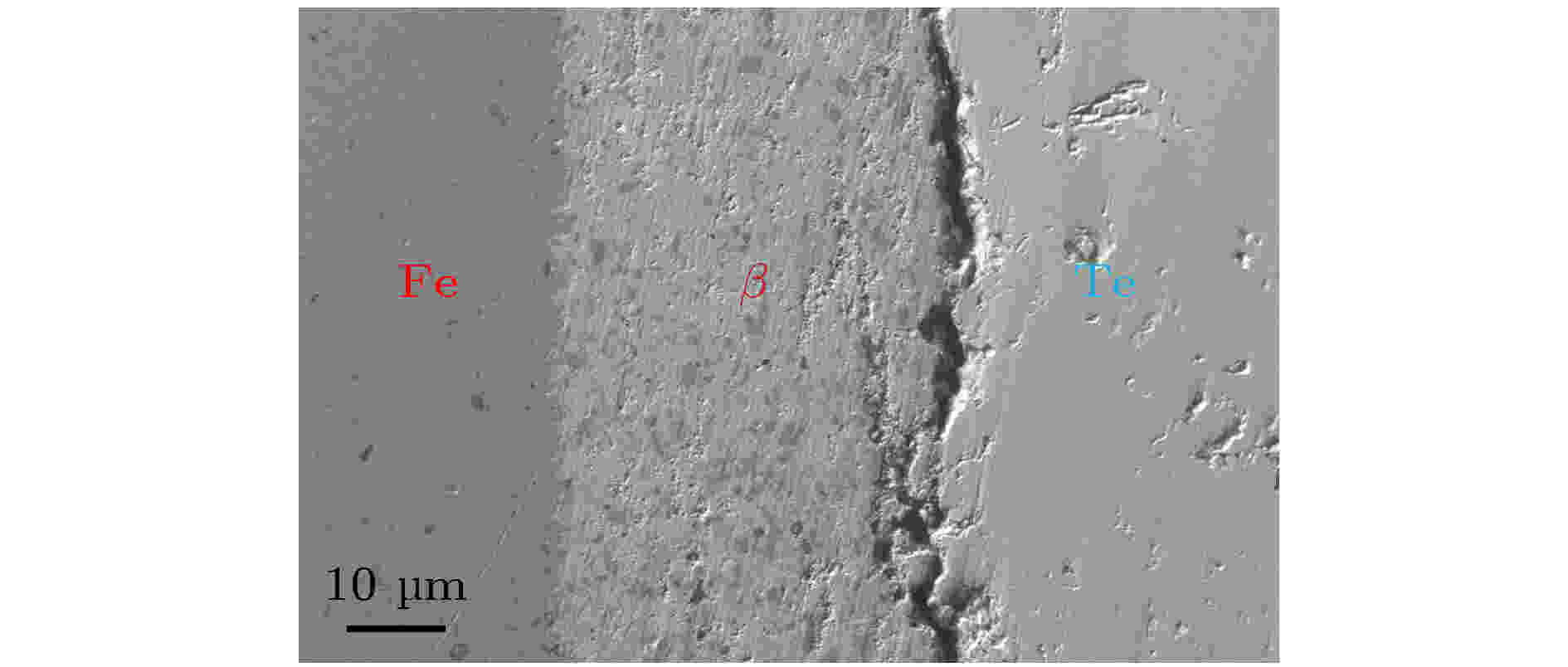 图 9 梯度连接结构Te/FeTe/Fe在573 K下退火10 d后的界面结构图片
图 9 梯度连接结构Te/FeTe/Fe在573 K下退火10 d后的界面结构图片Figure9. Interfacial structure picture of Te/β(FeTe)/Fe after annealing at 573 K for 10 d.
对梯度连接结构Te/β(FeTe)/Fe在523—573 K退火不同时间后的界面性能进行了测试, 目的是从界面性能变化的规律中总结界面质量的变化. 测试过程中发现, 在523 K退火15 d后, 连接样品的界面性能与退火前相比并未发生明显变化, 且界面组织结构保持稳定. 而在573 K退火10 d后, 连接结构的β(FeTe)-Te界面完全失效, 这是因为在573 K长时间退火时, 高温加速了界面处的反应层ε(FeTe2)相失稳分解, 导致界面结构破坏, 因此试样无法在此温度长时间保持稳定. 样品在553 K温度下退火过程中, 其界面组织结构以及材料基体形貌都发生了较明显变化, 因此对553 K温度下退火不同时间的试样界面性能进行分析. 图10(a)显示的是梯度连接结构的β(FeTe)-Fe界面接触电阻和剪切强度随退火时间的变化, 退火过程中界面处不可避免会出现一些微观组织缺陷, 结果显示界面接触电阻以及抗剪切强度表征的界面性能并未发生明显弱化, 保持在相对稳定水平. 试样在553 K退火15 d后, β(FeTe)-Fe界面接触电阻和剪切强度分别为17.17 μΩ·cm2和11.3 MPa. 图10(b)显示的是梯度连接结构的β(FeTe)-Te界面接触电阻和剪切强度随退火时间的变化. 可以发现, β(FeTe)-Te界面的剪切强度在553 K退火7 d内下降明显, 而在延长退火时间后, 此界面的剪切强度下降趋于平缓. 对照在553 K退火时连接界面组织结构变化, β(FeTe)-Te界面处的反应层ε(FeTe2)在553 K退火7 d后厚度变小, 是在反应层ε(FeTe2)相的晶格中的Te挥发引起的. 因此可以判断, 反应层中混合了少量Te的ε(FeTe2)相对β(FeTe)-Te界面有强化作用, 有利于界面机械性能的稳定. 而在ε(FeTe2)层的厚度在该温度下稳定后, 该界面的界面性能可以保持在稳定的服役水平. 退火15 d后, 测得的β(FeTe)-Te界面处接触电阻和剪切强度分别为30.91 μΩ·cm2和13.11 MPa.
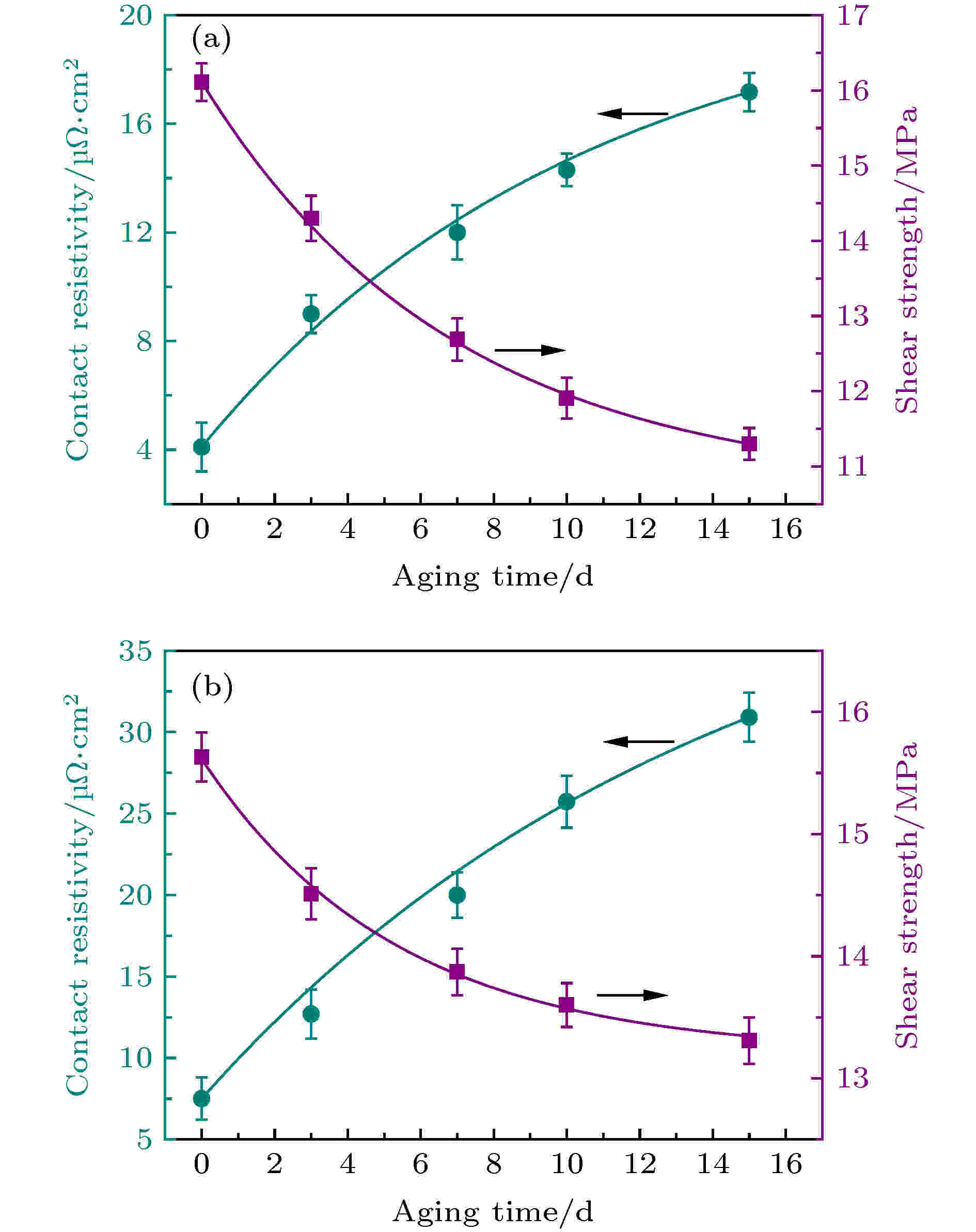 图 10 梯度连接结构Te/β(FeTe)/Fe在553 K下退火不同时间后界面性能的变化 (a) β(FeTe)-Fe界面; (b) β(FeTe)-Te界面
图 10 梯度连接结构Te/β(FeTe)/Fe在553 K下退火不同时间后界面性能的变化 (a) β(FeTe)-Fe界面; (b) β(FeTe)-Te界面Figure10. Changes in interface properties of Te/β(FeTe)/Fe after annealing at 553 K for different time: (a) β(FeTe)-Fe interface; (b) β(FeTe)-Te interface.
当以温度作为加速失效因素时, 接触电阻率的变化规律遵循阿伦尼乌斯公式:
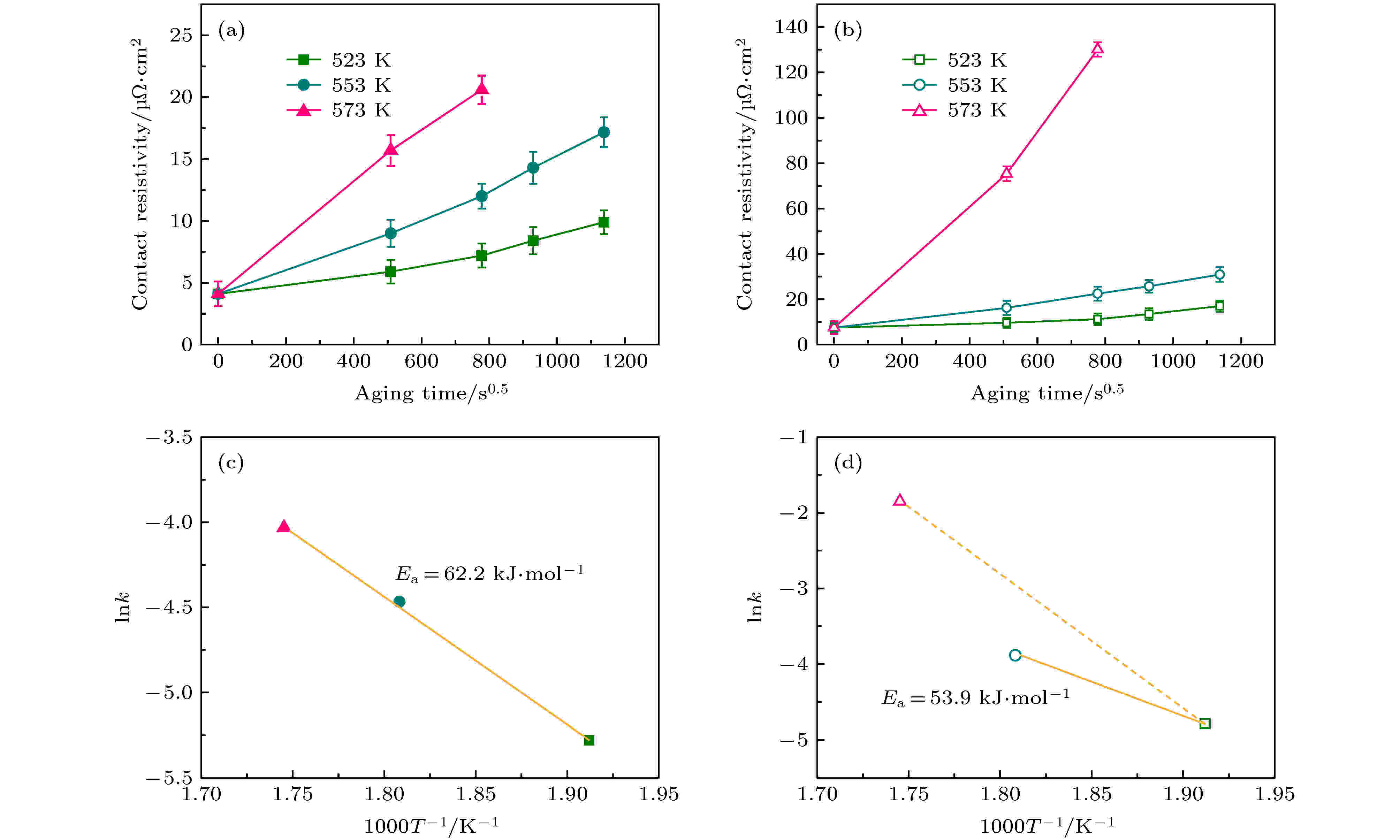 图 11 梯度连接结构Te/β(FeTe)/Fe界面接触电阻率随老化时间和温度的变化曲线 (a), (c) β(FeTe)-Fe界面; (b), (d) β(FeTe)-Te界面
图 11 梯度连接结构Te/β(FeTe)/Fe界面接触电阻率随老化时间和温度的变化曲线 (a), (c) β(FeTe)-Fe界面; (b), (d) β(FeTe)-Te界面Figure11. Change of interface resistivity with aging time and temperature: (a), (c) β(FeTe)-Fe interface; (b), (d) β(FeTe)-Te interface
对连接结构界面的热稳定性进行了测试. 在553 K退火15 d后, 热电接头的界面组织结构并未发生较大变化, β(FeTe)-Te与β(FeTe)-Fe间的接触电阻分别升为30.91和17.17 μΩ·cm2, 剪切强度分别降为13.11和11.3 MPa, 界面性能稍有弱化. 但将退火温度升到573 K后, β(FeTe)-Te界面性能迅速下降, 并在10 d后结构完全被破坏. 所以该梯度连接结构的稳定服役温度不宜高于553 K.
本研究以本征Te作为热电材料进行连接, 并未对其热电性能进行改善, 后续研究将致力于Te基热电材料性能的提升, 以提升整个热电接头的性能.
感谢美国西北大学的G. Jeffery Snyder教授及其团队在性能测试和数据分析方面给予的帮助.
